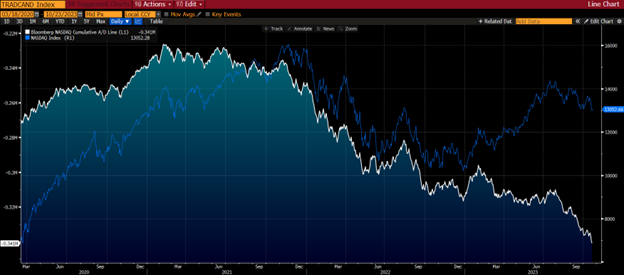Market internals breaking down; Thanks, Fed & Treasury — Week of October 23, 2023

| index | wtd | ytd | 1-year | 3-year | 5-year | index level |
|---|---|---|---|---|---|---|
| S&P 500 Index | -2.38 | 11.45 | 17.15 | 8.72 | 10.69 | 4,224.16 |
| Dow Jones Industrial Average | -1.57 | 1.67 | 11.61 | 7.54 | 7.72 | 33,127.28 |
| Russell 2000 Small Cap | -2.25 | -3.43 | 0.13 | 2.57 | 3.09 | 1,680.79 |
| NASDAQ Composite | -3.16 | 24.87 | 23.42 | 4.92 | 12.77 | 12,983.81 |
| MSCI Europe, Australasia & Far East | -1.66 | 4.90 | 20.45 | 4.82 | 4.64 | 1,978.98 |
| MSCI Emerging Markets | -2.15 | -0.24 | 10.88 | -3.68 | 1.95 | 930.80 |
| Barclays U.S. Aggregate Bond Index | -2.03 | -3.44 | 0.94 | -5.84 | -0.18 | 1,978.31 |
| Merrill Lynch Intermediate Municipal | -1.13 | -1.80 | 1.43 | -1.96 | 1.25 | 293.42 |
As of market close October 20, 2023. Returns in percent.
Investment Insights
— Steve Orr
Bear flag
Last Friday’s price action in stocks marked another low for this Bull cycle. The S&P 500 closed below its 200-day moving average for the first time since March. The index’s 8% drop since July’s high makes a Bear Flag chart formation. Bear Flags usually mark the continuation of a trend. That would help the Bull cause, as the last two and a half months have sown doubt amongst the faithful. Skipping the March bank deposit dip, the S&P 500 rose roughly 12% from February in the spring/summer rally. The Fed raised short-term rates three times during that run, but financial conditions were fairly easy as long as interest rates and the dollar were fairly quiet.
Those tables turned in August once the Treasury ramped up debt issuance. The dollar responded to more Treasury supply by running 3% higher. Oil prices gained 12% through last Friday following the dollar and supply cuts overseas. Inflation and the possibility of one more rate increase by the Fed also tip the scales for the Bears. Finally, being able to earn 5% on cash is a nice problem to have. Stocks have dealt with higher rates in the past and done fine. We would argue that it is the speed over the last year of the rate increases that hurts earnings going forward. Corporate debt will need to be refinanced at double or higher the rates of two years ago. Wages have jumped and are not going back.
We would like to see strong earnings over the next two weeks help the big index break out of the Bear Flag pattern to the upside. Some $10 trillion of market cap reports earnings this week. Mega-techs Amazon, Facebook (oops, Meta), Google and Apple will set the tone. Only 17% of the S&P 500 have reported to date, and according to FactSet, are averaging -0.4% year-over-year decline. Some solid surprises are needed to turn sentiment and breadth back in the Bull’s favor. Breadth for the NASDAQ index has been particularly bad: new lows over new highs at, yes, new highs. The advance/decline line, an indicator that shows the number of rising stocks minus the number of falling stocks, is plumbing new lows. As the chart below shows, the white A/D line peaked a year after shutdowns and started falling before the NASDAQ peaked. Since July, the number of falling stocks in the index has accelerated.

Source: Bloomberg
The geopolitical backdrop for earnings cannot be ignored. Our scorecard now reads five major wars around the globe. The space war of intelligence gathering and shooting at satellites is out of view (literally) to most folks. The cyber war is omnipresent but in the background. Ukraine, Africa coups and Iran-Israel are front and center in the news. Both Ukraine and Israel have the potential to drag on for years. The antagonists have the advantage of selling oil on the open market to finance their attacks. The defenders must rely on the generosity of other nations. Resources will be diverted, shipping lanes delayed or shut, and uncertainty will reign. It will be harder to forecast returns, with wider bands of uncertainty. The S&P 500’s 50-day moving average sits about 3.5% above the 200 day. If price action in the coming weeks pulls the 50 below 200, that would be a significant change in our trend indicator scoring.
Changing the score
We are not positive, but we think every FOMC member was on the lecture circuit at least once last week. At least two members were on the tape two weeks ago floating the idea that the recent rise in long-term interest rates could do the Fed’s job for it. In other words, rates have risen high enough that they are taking the place of more Fed rate hikes. Last week’s speakers followed this line of thinking. Okay, we get it — there will be no rate increase in the Fed Funds rate at the November 1 meeting. FOMC members have been unanimous in saying they are “data dependent” and will not rest until inflation is at 2%.
Fed Chairman Powell spoke Thursday at the Economics Club of New York. Protestors against oil interrupted his speech to the point where he had to be led from the room. We wonder 1) if they were given the wrong cue cards, and 2) did they walk to the Club or use fossil fuels? They should have been protesting the Fed moving rates too far, too fast. He pointed out that the Fed “could” raise rates to fight inflation in the future, not “would” or “should.” So he, too, is probably in the “no raise” camp for the November meeting. He also remarked that he was surprised that the economy appears to be growing so strong. He followed that rather obvious thought with the statement that rates have not been high enough for long enough and that policy is not “too tight” right now.
We would disagree. The effects of higher rates have not moved through the economy yet. Please note that one third all U.S. debt, Treasury, old mortgages, corporate, municipal, credit card, etc. will mature within the next 13 months. That debt averages about 3% interest rate. At what rate will it refinance over the next year? Double? Sounds reasonable. The Fed is looking ahead and seeing the impact of higher rates on earnings and consumer incomes, calling a pause before their beloved 2% inflation rate is reached, maybe moving the goalposts. But continued rate increases to attack inflation quicker may create much heavier burdens for corporations and consumers alike.
We do not think higher rates alone will knock down inflation. Higher rates will crimp cash flow and discretionary spending as more funds are needed to pay interest. The Fed hopes that higher expenses will cause employers to hire less and in turn, slow employment growth. This is the route they believe will get them to 2% inflation. We will wait and see.
Wrap-Up
Interest rates remain at 20-year highs. The 10-year Treasury has experienced the largest drawdown in its history. For the last 12 years, the economy was financed at near zero rates. The rate rise engineered by the Fed will create further damage across the economy.
Higher rates have made cash competitive with stocks and more attractive than long-maturity bonds. We realize that some bond investors are tempted by a 5% yield on the 10-year Treasury. We would caution that they are viewing rates in the context of the last several years. The correct lens is more like 200 years where 4.5% is the average. There is a path via strong earnings to a fourth-quarter rally. We believe we are being paid to wait and see if those earnings come to pass.
Steve Orr is the Managing Director and Chief Investment Officer for Texas Capital Bank Private Wealth Advisors. Steve has earned the right to use the Chartered Financial Analyst and Chartered Market Technician designations. He holds a Bachelor of Arts in Economics from The University of Texas at Austin, a Master of Business Administration in Finance from Texas State University, and a Juris Doctor in Securities from St. Mary’s University School of Law. Follow him on Twitter here.
The contents of this article are subject to the terms and conditions available here.